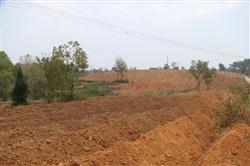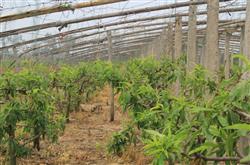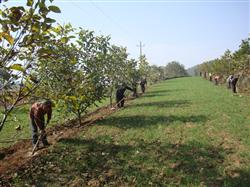How to plant sweet peaches?

How to plant sweet peaches? Please introduce in detail the planting method of sweet peach, also known as red peach, is a kind of deciduous fruit tree, belonging to small and medium-sized fruit. In the case of no fruit thinning, the single fruit weight is about 100 grams. Artificial fruit thinning cultivation can increase the single fruit weight to 150 grams, and the maximum fruit weight can reach 250 grams. After trial planting in Guangdong, the fruit ripening period is in the middle and late May. The fruit is bright red when ripe, crisp, sweet, good flavor, hard, resistant to storage, pulp and core are not completely separated. Planted in that year, the next year's plant yield can reach more than 3 kg, is a very promising new variety of fruit trees, the following introduction of sweet peach planting techniques for reference: 1, soil: peach trees are not picky about the choice of soil quality. Peach trees cultivated in fertile areas, the branches are easy to grow, it is not easy to adjust the tree potential by fertilization and other cultivation techniques, but grow slowly on sandy soil, easy to produce flower buds, even if laissez-faire cultivation can have a considerable harvest. However, no matter what kind of soil is planted, it must be well drained, otherwise the roots will gradually rot after three or four years of planting. The resistance of peach trees to waterlogging is so weak that it is possible to die after flooding for more than 8 hours. Peach trees avoid shade and good sunshine, where the sunshine is insufficient, the photosynthesis is weak, and the sweetness of the fruit is reduced. 2. Fertilization: the amount of fertilizer application should be adjusted according to the actual soil fertility and soil fertility of the orchard. Generally, a four-year-old peach tree needs 150ml 300g of nitrogen, 70g of phosphorus, and 250g of potassium. According to this standard, and with reference to soil, climatic conditions, and types of fertilizer, it can be divided into one basic fertilizer, that is, after the fruit trees have fallen leaves, organic manure is mainly applied, and compost, irrigation, bean cake and chicken dung are commonly used together with chemical fertilizers such as phosphorus and potassium. The earlier the organic fertilizer is applied, the better it can be absorbed when it sprouts. When using compound fertilizer, a small amount of compound fertilizer should be applied, usually in the early fruiting stage, fruit fattening period and harvest time. However, the topdressing after harvest should not be too late, otherwise the shoots will grow too long and it is not easy to enter the dormancy state, which is bound to affect the blossom and fruit in the coming year. 3. Fruits and vegetables: to do a good job of fruits and vegetables is the key to determine whether the cultivation is successful or not. when fruits and vegetables are left on a fruit-bearing branch, the fruit is well-developed and normal in shape. in terms of the fruit, the fruit in the middle and base is better than the fruit at the top, so the top fruit is sparse, and the fruit above the fruit is colored earlier, but the fruit is unstable, so the fruit under the skin on the side is better, and the number of fruits and vegetables should not be too large. Generally speaking, there are 20 leaves in a fruit and 20 to 250000 fruits in a hectare, which can be considered according to the actual tree age and tree potential. When fruits and vegetables, the type of fruit should also be adjusted, in principle, short, medium fruit branches leave one fruit. On the other hand, there were 3 fruits left on the long fruit branches. When there are a large number of long fruit branches, there are 2 fruits left on each long fruit branch, while no fruit is left on the medium and short fruit branches. 4. Prevention and control of diseases and insect pests: prevention and control of peach root rot and gum disease to improve soil fertility and chemical control. The main way to improve soil fertility is to apply organic fertilizer to increase the content of soil organic matter. Chemical control, can be used before germination with 5 degrees stone sulfur mixture full spray, or with pentachloronitrobenzene and other fungicides root coating disease spot. To control peach aphids, peach heart borer and brown helmet scale, we should grasp the clear garden in late March and choose poison, imidacloprid and so on. 5. Harvest: sweet peach is a kind of honey peach, which has the best flavor when it is ripe, but for the consideration of transportation, sale and sale, it is mostly harvested when it is ripe at 7 / 8. When harvesting, you should first take the fruit at the top of the crown, depending on the background color of the pericarp. When the original green has completely disappeared and turned pale, and the colored part has been bright red, it can be harvested. 6. Pruning and pruning: most of the branches of peach trees are open, so open-heart pruning is appropriate. In order to obtain ideal sunshine, the method is that there are 3 main branches of the main branch, which leads to the first main branch at the above-ground 30ml 40cm, and then leaves the second and third main branches every 20m / 25cm on the trunk. The angle between the main branch and the trunk is about 30 degrees. The distance between the main branches and the sub-main branches is 120cm apart. The number of sub-main branches on each main branch is 3mur. it is necessary to balance each other and avoid overlap and crossing. the angle of sub-main branches and main branches is about 25Mel and 30 degrees. Pruning is divided into two types: 1. Thinning in winter: cutting off too many fruiting branches and other useless branches since the branches diverge from the base. The main branch is trimmed short to produce powerful new branches from the main branch or sub-main branch. Cut off the old and old branches and renew them into new ones to achieve metabolism. 2. Summer pruning: (1) picking stamens; the new branches occurring at the base of the trunk and main branches and sub-main branches may become overgrown branches and affect the tree potential, so the growing point should be picked as soon as possible before the shoot is lignified. (2) shoot removal: before the new branch is completely Lignified, remove its top tip to inhibit the continuous elongation or promote the occurrence of lateral branches, or to make the branch stout. (3) twisting: if the new branch has been formed and completely lignified, it is feasible to twist the branch, pick the stamens and not reach the purpose, and when the second branch is sent out, twisting can also be carried out to ease the growth. Click to get more peach tree planting techniques click to get more fruit planting techniques
- Prev

How to prune newly planted peach trees?
How to prune newly planted peach trees? When does the newly planted peach tree have the best pruning effect? Please give an introduction to guide the annual growth of peach trees, and the buds have a strong early maturity, the newly planted peach trees can sprout 3 or 4 times in that year. Therefore, we can make use of this characteristic of peach trees, under the premise of strengthening fertilizer and water management, through summer clipping.
- Next

How to manage walnut trees in autumn?
How to manage walnut trees in autumn? What do walnut trees need to pay attention to in autumn? Please introduce the fruit period of walnut trees in autumn. Due to the need of fruit, walnut trees consume a lot of nutrients. Fruit trees are characterized by weakness, obvious increase in diseases and insect pests, and even the structure of trees has changed.
Related
- Moge, come on! The staff of the peasant association in the producing area of cantaloupe were frightened when the crowd gathered.
- Causes and Solutions of low Fruit setting rate of Apple
- Symptoms and control measures of passion fruit virus disease
- Fruit growing lesson: how do apple orchards keep high yields?
- Can you build orchards in the mountains? What are the pros and cons?
- How to manage the coloring period of Crisson grape?
- This paper introduces the processing technology of two kinds of fig products.
- How much is a month for retired teachers in rural areas by 2020?
- How can strawberry planting increase sugar content? We should pay attention to management in many aspects.
- What are the cultivation techniques on how to improve the yield of golden fruit?

